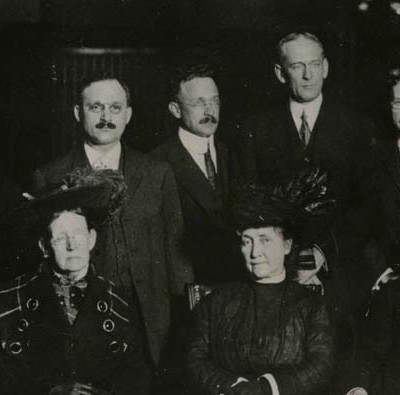
Louis Israel Aaron (1840-1919) was born in Moschin, Prussia, which is in present-day Poland. He immigrated to the United States from Hamburg in 1857. He spent nearly two years working for his uncle in New York before moving to Atlanta to work as a salesman for a dry goods store. He returned to New York in April 1860 to avoid being drafted into the Confederate Army, as he explained in a brief autobiographical document about 1903. He came to Pittsburgh in 1861 to work as a salesman for A. Lippman & Co.
During his early years in Pittsburgh, Aaron served in the “home guard.” He was stationed at a fortification on Mount Washington, one of at least 37 facilities built in and around Pittsburgh during those years to prevent a Confederate attack on the city.
In 1879, Aaron went into the malt, hops and brewers’ supply business with Jacques Weil (c.1853-1916) under the name Weil and Aaron. They grew the business over the next seven years before splitting into separate concerns. In 1886, Aaron incorporated the Louis I. Aaron Company, a malt manufacturing business. He sold the business to the American Malting Company in 1896. The following year, he bought into the Homer Laughlin China Company of East Liverpool, Ohio, and became its president.
On the occasion of his 70th birthday in 1910, Aaron donated $59,800 to numerous charities, including the J.M. Gusky Home and Orphanage, the Jewish Home for the Aged and the Irene Kaufmann Settlement House. He paid particular attention to hospitals and orphanages, and his donations were not limited to his faith or to his city. The donations attracted considerable attention. “It’s nothing to make a fuss about,” Aaron told reporters at the time. “I just got to thinking that I would enjoy seeing some good done with my money while I was alive. You know, the flowers you pick while you are living are a whole lot sweeter than the kind they put on your grave.”
In 1913, Rabbi Aaron Mordechai Ashinsky persuaded Aaron to make a $25,000 contribution toward a building fund for the emerging Hebrew Institute of Pittsburgh.
Louis Aaron married Mina M. Lippman on October 21, 1866. They had five children, although only two sons, Marcus and Charles, survived to adulthood.
Marcus Aaron (1869-1954) attended the Conway School and the Preparatory Department of the University of Western Pennsylvania. Marcus worked for his father at the Louis I. Aaron Company and in 1911 succeeded his father at the Homer Laughlin China Company. He also gained local recognition as a long-serving member of the Pittsburgh Board of Education. He joined the board in its inaugural year in 1911 and retired in 1947, serving as its president from 1922 to 1942. He served on the State Board of Education from 1916 to 1921 and the State Council of Education from 1921 to 1923. Aaron was an advocate for retaining an appointed school board to shield its members from political influence. On the state level, he was instrumental in the passage of the Edmunds Act in 1933, which established salary schedules for teachers. “Universal education is not a panacea for every ill, but it is a necessary preventative of many ills to which democracy is subject,” Aaron said in 1919. “Our democracy will function and endure only if our citizens learn to think clearly and correctly.”
Marcus Aaron married Stella Hamburger (1877-1950) on November 23, 1898. They had two children, Marcus Lester (1900-1994) and Fannie Hamburger (1902-1952).
Marcus Lester Aaron succeeded his father as president of the Homer Laughlin China Company in 1940. Louis Aaron, Marcus Aaron and Marcus Lester Aaron all served on the board of trustees at Rodef Shalom Congregation. Marcus Aaron was president from 1930 to 1941, and Marcus Lester Aaron was president from 1953 to 1972.
In 1926, Marcus Lester Aaron married Maxine Goldmark (1903-1996), who continued the family commitment to public education. She was a graduate of the Horace Mann School for Girls and Vassar College. Her involvement in the local school system began in the Parent Teacher Associations of the public schools that her four children attended. She was president of the Pittsburgh Council of the Parent Teacher Association at the time of her appointment to the Pittsburgh Board of Public Education in 1948. She was vice president of the school board from 1953 to 1956 and its first female president from 1966 to 1969. She retired in 1975. Known for her modest style, she handled a series of highly consequential issues during her tenure as president, including inadequate funding, struggles to integrate the school system racially and the 1968 teachers’ strike.
“The quality of life in American cities will depend in large measure on the character and quality of Public Education,” she wrote to Judge Henry Ellenbogen in 1975. “It is my earnest hope that the community will continue to support the Public Schools and that the Board will furnish the necessary leadership as trustees for all the children of Pittsburgh.”